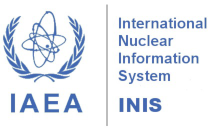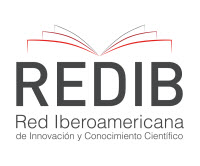Detetores de estado sólido para traços nucleares aplicados na avaliação da exposição ao radônio de trabalhadores de minas de tanzanita de pequena escala na Tanzânia
DOI:
https://doi.org/10.15392/2319-0612.2025.2829Palavras-chave:
radão, minas subterrâneas, exposição ocupacional, SSNTDResumo
Os detetores de estado sólido de traços nucleares (SSNTD) tipo CR-39 foram utilizados para medir os níveis de gás radônio nos blocos B, C e D de mineração de tanzanita em pequena escala na área de Mirerani, no norte da Tanzânia. A exposição dos trabalhadores ao radônio foi avaliada utilizando os conceitos de nível de trabalho, nível de trabalho mês e fatores de conversão de dose recomendados pela Comissão Internacional de Proteção Radiológica (ICRP). Os resultados revelaram que os níveis de radônio variaram entre abaixo do nível de ação de 300 Bqm-3 recomendado pelo ICRP até 5,3 vezes mais elevado. As doses médias anuais efetivas correspondentes variaram de 0,8 a 11,8 mSvy-1, 1,4 a 4,4 mSvy-1 e 1,9 a 2,3 mSvy-1 para os blocos B, D e C, respetivamente. Estes resultados indicam que as doses estimadas estão abaixo do limite regulamentar de 20 mSv y-1. No entanto, recomendam-se medidas para manter as exposições tão baixas quanto razoavelmente possível à medida que a mineração avança para camadas mais profundas, onde os meios de ventilação disponíveis podem não ser suficientes para reduzir os níveis de exposição ao radônio.
Downloads
Referências
[1] MOHAMMED, N.K., MAZUNGA, M.S. Natural radioactivity in soil and water from likuyu village in the neighborhood of mkuju uranium deposit. International Journal of Anal Chem. 2013; 501856, 2013. Available: https://doi.org/10.1155/2013/501856. DOI: https://doi.org/10.1155/2013/501856
[2] FOCUS, E., RWIZA, M.J., MOHAMMED, N.K., BANZI, F.P. The influence of gold mining on radioactivity of mining sites soil in Tanzania. International Journal of Environmental Quality;46: 46-59, 2021. DOI: https://doi.org/10.1155/2021/9976048
[3] MBUYA, A.W., MBUYA, I.B.,MBOYA, I.B., SEMVUA, H.H., MSUYA, S.E., HOWLETT, P.J., MAMUYA, S.H.. Concentrations of respirable crystalline silica and radon am ong tanzanite m ining com m unities in Mererani, Tanzania. Ann Work Expo Health . 8;68(1):48-57, 2024. doi: 10.1093/annweh/wxad062. DOI: https://doi.org/10.1093/annweh/wxad062
[4] DONOGHUE, A. Occupational Health Hazards in mining-An overview. Journal of Occupational Medicine, Volume 54, No. 7, 2004. DOI: https://doi.org/10.1093/occmed/kqh072
[5] HOY, R.F., CHAMBERS, D.C. Silica-related diseases in the modern world. Allergy Eur. J Allergy Clin Immunol.75:2805 – 2817, 2020. https://doi.org/10.1111/all.14202. DOI: https://doi.org/10.1111/all.14202
[6] ZEEB, H. and SHANNOUN, F., Eds. WHO Handbook on In-Door Radon: A Public Health Perspective. World Health Organization, Geneva. 2009.
[7] UNSCEAR (United Nations Scientific Committee on the Effects of Atomic Radiation). Sources and effects of ionizing radiation; report to the General Assembly, with scientific annexes, United Nations, New York, 2000.
[8] CIGNA, A.A. Radon in Caves. International Journal of Speleology. 34 (1-2), 1 – 18, 2005. DOI: https://doi.org/10.5038/1827-806X.34.1.1
[9] MARGINEANU, R.M.(2019). Radon measurements in underground mines and caves from several European countries. AIP Conference Proceedings 2076, 050004 (2019); https://doi.org/10.1063/1.5091643. DOI: https://doi.org/10.1063/1.5091643
[10] TEIRI, H., NAZMARA, S., ABDOLAHNEJAD, A., HAJIZADEH, Y., AMIN , M.M. Indoor radon measurement in buildings of a university campus in central Iran and estimation of its effective dose and health risk assessment. J Environ Health Sci Engineer 19, 1643–1652, 2021. https://doi.org/10.1007/s40201-021-00720-y. DOI: https://doi.org/10.1007/s40201-021-00720-y
[11] ICRP (INTERNATIONAL COMMISSION ON RADIOLOGICAL PROTECTION). Protection Against Radon-222 at Home and at Work. ICRP Publication 65. Ann. ICRP 23 (2), 1994.
[12] HUNGARIAN REGULATION 10 16/2000, 2000. Ministry of Health implementing the provisions of the law No. CXVI. of the year 1996.
[13] ICRP (INTERNATIONAL COMMISSION ON RADIOLOGICAL PROTECTION). The 2007 Recommendations of the International Commission on Radiological Protection. ICRP Publication 103. Ann. ICRP. 37 (2-4), 2007.
[14] BOYD, M.A. The Confusing World of Radiation Dosimetry – 9444, WM2009 Conference, March 1–5, 2009, Phoenix.
[15] IAEA (INTERNATIONAL ATOMIC ENERGY AGENCY). Safety Standards Series No. GSR Part 3 (Interim)-Radiation Protection and Safety of Radiation Sources: International Basic Safety Standards. IAEA, Vienna, (2011).
[16] NRC (US NUCLEAR REGULATORY COMMISSION). NRC Regulations Title 10, Code of Federal Regulations; Part 20 - Standards for Protection Against Radiation. The U.S. Nuclear Regulatory Commission, Washington, DC, (2011).
[17] COUNCIL OF THE EUROPEAN UNION (2014). Council directive 2013/59/EURATOM, European Basic Safety Standards (BSS) for protection against ionising radiation Official Journal of the European Union, L 13/1. http://eur-lex.europa.eu/legal content/EN/TXT/?uri=CELEX:32013L0059.
[18] ICRP (INTERNATIONAL COMMISSION ON RADIOLOGICAL PROTECTION). 126 Radiological Protection against Radon Exposure. ICRP Publication 126. Ann. ICRP 43(3), 2014. DOI: https://doi.org/10.1177/0146645314542212
[19] La VERDE, G., ROCA, V., SABBARESE,C., AMBROSINO, F., PUGLIESE, M. (2018). The equilibrium factor in the radon dose calculation in the archaeological site of Acquedotto Augusteo del Serino in Naples. IL NUOVO CIMENTO 41 C, 2018. DOI10.1393/ncc/i2018-18218-1.
[20] ICRP (INTERNATIONAL COMMISSION ON RADIOLOGICAL PROTECTION). Occupational Intakes of Radionuclides: Part 3. ICRP Publication 137. Ann. ICRP 46(3/4), 2017. DOI: https://doi.org/10.1177/0146645317734963
[21] NCRPM (NATIONAL COUNCIL ON RADIATION PROTECTION AND MEASUREMENTS). Measurement of Radon and Radon Daughters in Air. NCRP Report No.97, 1988.
[22] PORSTENDÖRFER, J., BUTTERWECK, G., REINEKING, A. Daily variation of the radon concentration indoors and outdoors and the influence of meteorological parameters. Health Phys. 67(3):283-7, (1994). doi: 10.1097/00004032-199409000-00011. DOI: https://doi.org/10.1097/00004032-199409000-00011
[23] Di CARLO,C., AMPOLLINI,M., ANTIGNANI,S., CAPRIO,M., CARPENTIERI,C., CACCIA,B., BOCHICCHIO, F. Extreme reverse seasonal variations of indoor radon concentration and possible implications on some measurement protocols and remedial strategies. Environmental Pollution, Volume 327,15, 2023. https://doi.org/10.1016/j.envpol.2023.121480. DOI: https://doi.org/10.1016/j.envpol.2023.121480
[24] RAMOLA, R.C., RAWAT, R.B.S., KANDARI, M.S., RAMACHANDRAN,T.V., EAPPEN, K.P., SUBBA RAMU M.C. Calibration of LR-115 Plastic Track Detectors for Environmental Radon Measurements. Indoor and Built Environment. 1996; 5(6):364-366, 1996. doi:10.1177/1420326X9600500610. DOI: https://doi.org/10.1159/000463753
[25] BAKACAK, P.K., EKINCI, N., KAVAZ, E. Determination of Radon Concentration by Using CR-39 Plastic Track Detectors in Dwellings of Bingöl and Mus Provinces of Turkey. Asian Journal of Chemistry 30(1):226-230, 2018. DOI:10.14233/ajchem.2018.21094. DOI: https://doi.org/10.14233/ajchem.2018.21094
[26] HASHIM, A.K., A.K., HATIF, A.R., AHMED, N.M., WADI, I.A., AL QAAOD,A.A. Comparison study of CR-39 and CN-85 detectors to evaluate the alpha radioactivity of some samples of drinks in Iraq. Applied Radiation and Isotopes. 167. 109410, 2021 DOI: https://doi.org/10.1016/j.apradiso.2020.109410
[27] CHACHAGE, C.S.L. “The Meek Shall Inherit the Earth but not the Mining Rights: The Mining Industry and Accumulation in Tanzania.” In Liberalised Development in Tanzania, edited by P, Gibbon, 37-109, 1995. Uppsala: Nordiska Afrikainstitutet.
[28] HELLIESEN, M.S. Tangled up in Blue: Tanzanite Mining and Conflict in Mererani, Tanzania, Critical African Studies, 4:7, 58-93, 2012. DOI: 10.1080/21681392.2012.10597799 DOI: https://doi.org/10.1080/21681392.2012.10597799
[29] THE TANZANITE EXPERIENCE, available online at:
https://www.tanzaniteexperience.com/tanzanite-mining-all-you-need-to-know/#toc-280191-1; accessed on 4th March 2025.
[30] SHAHROKHI, A., KOVÁCS, T. Characterization of environmental radiological parameters on dose coefficient - Realistic dosimetry compared with epidemiological dosimetry models. Heliyon, 2023 ; https://doi.org/10.1016/j.heliyon.2023.e19813. DOI: https://doi.org/10.1016/j.heliyon.2023.e19813
[31] KAHULUDA, E.M., ISMAEL, N. MAKUNDI.. Determination of Radon Gas and Respirable ore dust concentrations in the underground Merelani Tanzanite Mines. Tanzania Journal of Science .(40): 13 – 19, 2014.
Downloads
Publicado
Edição
Seção
Licença
Direitos autorais (c) 2025 Shovi F. Sawe

Este trabalho está licenciado sob uma licença Creative Commons Attribution 4.0 International License.
Declaro que o presente artigo é original, não tendo sido submetido à publicação em qualquer outro periódico nacional ou internacional, quer seja em parte ou em sua totalidade. Declaro, ainda, que uma vez publicado na revista Brazilian Journal of Radiation Sciences, editada pela Sociedade Brasileira de Proteção Radiológica, o mesmo jamais será submetido por mim ou por qualquer um dos demais co-autores a qualquer outro periódico. Através deste instrumento, em meu nome e em nome dos demais co-autores, porventura existentes, cedo os direitos autorais do referido artigo à Sociedade Brasileira de Proteção Radiológica, que está autorizada a publicá-lo em meio impresso, digital, ou outro existente, sem retribuição financeira para os autores.
Licença
Os artigos do BJRS são licenciados sob uma Creative Commons Atribuição 4.0 Licença Internacional, que permite o uso, compartilhamento, adaptação, distribuição e reprodução em qualquer meio ou formato, desde que você dê o devido crédito ao (s) autor (es) original (is) e à fonte, forneça um link para a licença Creative Commons, e indique se mudanças foram feitas. As imagens ou outro material de terceiros neste artigo estão incluídos na licença Creative Commons do artigo, a menos que indicado de outra forma em uma linha de crédito para o material. Se o material não estiver incluído no licença Creative Commons do artigo e seu uso pretendido não é permitido por regulamentação legal ou excede o uso permitido, você precisará obter permissão diretamente do detentor dos direitos autorais. Para visualizar uma cópia desta licença, visite http://creativecommons.org/licenses/by/4.0/






















